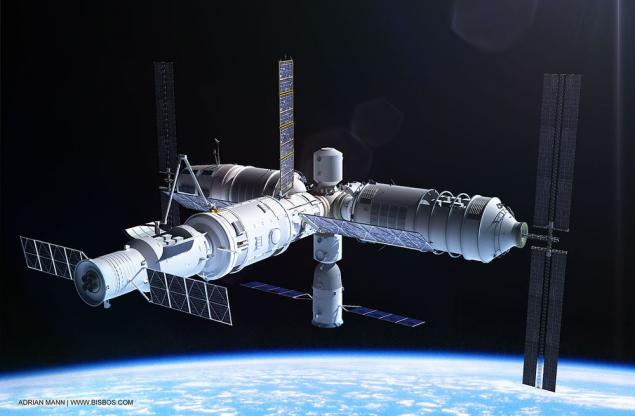China published a scheme Space Station "Tiangong-3"
 Bashny.Net
Bashny.Net
China National Space Administration issued a framework for future space "Tiangong-3" station, which is planning to launch in the 2018-2022 years.

"Tiangong-3" Core module space station called "Tianhe-1", which means "Galaxy 1". It will include laboratory and modular sections for storage of scientific equipment, robotic arm and five docking ports. This module has a mass of 24 tonnes, its length - 18, 1 m, diameter - 4, 1 meter. The module scheduled for launch in 2018 with the help of a rocket "Long March-5", it will be a hub for future modules and to recharge, sent to Earth with the station.
Outwardly, "Tianhe-1" reminds modules "Star" or base station "Mir", which are based on the "Salyut" station in turn. Therefore module configuration may resemble a "World", the first multi-module space station.

scheme core module "Tianhe-1»
At the space station, "Tiangong-3" will be two scientific modules: «Wengtian» and «Mengtian». These modules will conduct research in microgravity. Both modules will be a 14, 4 meters and a diameter of 4, 1 meter - as the main module.
«Wengtian» equip modular internal racks, its own robotic arm to help the team in experiments outside the station. Module «Mengtian» will have an additional port for docking with other modules, and ships for the logistics and repairs, as well as to exit taikonaut into space.
«Wengtian» and «Mengtian» withdraw into orbit and dock with the main module in the years 2020-2022.

scheme research module «Wengtain»

scheme research module «Mengtain»
At the station "Tiangong-3" will fly a series of manned spacecraft "Shenzhou" and cargo ships "Tyanchzhou". Multi-module space station will operate for 10 years. It will serve the next space telescope «Xuntian» 2-meter mirror and a field of view up to 300 times greater than the "Hubble" NASA.
The first Chinese space laboratory "Tiangong-1" was launched in 2011. In June 2012, three taikonaut profit "Shenzhou-9" on the station manned spacecraft. Right from the onboard laboratory cosmonauts taught physics Chinese students. Now the station is not used in a single module. This year, China plans to launch the "Tiangong-2", the module will take a team of astronauts. Both of these stations - stages of a space program, which will result in China's space station in 2022.
Source: geektimes.ru/post/276190/

"Tiangong-3" Core module space station called "Tianhe-1", which means "Galaxy 1". It will include laboratory and modular sections for storage of scientific equipment, robotic arm and five docking ports. This module has a mass of 24 tonnes, its length - 18, 1 m, diameter - 4, 1 meter. The module scheduled for launch in 2018 with the help of a rocket "Long March-5", it will be a hub for future modules and to recharge, sent to Earth with the station.
Outwardly, "Tianhe-1" reminds modules "Star" or base station "Mir", which are based on the "Salyut" station in turn. Therefore module configuration may resemble a "World", the first multi-module space station.

scheme core module "Tianhe-1»
At the space station, "Tiangong-3" will be two scientific modules: «Wengtian» and «Mengtian». These modules will conduct research in microgravity. Both modules will be a 14, 4 meters and a diameter of 4, 1 meter - as the main module.
«Wengtian» equip modular internal racks, its own robotic arm to help the team in experiments outside the station. Module «Mengtian» will have an additional port for docking with other modules, and ships for the logistics and repairs, as well as to exit taikonaut into space.
«Wengtian» and «Mengtian» withdraw into orbit and dock with the main module in the years 2020-2022.

scheme research module «Wengtain»

scheme research module «Mengtain»
At the station "Tiangong-3" will fly a series of manned spacecraft "Shenzhou" and cargo ships "Tyanchzhou". Multi-module space station will operate for 10 years. It will serve the next space telescope «Xuntian» 2-meter mirror and a field of view up to 300 times greater than the "Hubble" NASA.
The first Chinese space laboratory "Tiangong-1" was launched in 2011. In June 2012, three taikonaut profit "Shenzhou-9" on the station manned spacecraft. Right from the onboard laboratory cosmonauts taught physics Chinese students. Now the station is not used in a single module. This year, China plans to launch the "Tiangong-2", the module will take a team of astronauts. Both of these stations - stages of a space program, which will result in China's space station in 2022.
Source: geektimes.ru/post/276190/
Tags
See also
BMW offers to install lights in the streets with the connector for charging electric vehicles
"Ukrposhta" promises to deliver the goods from Chinese online stores this week
The most popular street food of different countries
A popular street food in different countries
A popular street food in different countries (11 photos)
Edible city
NASA plans in 2021 to open a greenhouse on Mars
"Smart" Parking – fee for air pollution
China is about to launch into orbit station "Tiangong-2" in 2016
The Chinese space program: own rover, space station by the end of the next five-year period plus heavy booster

















